You can Download Samacheer Kalvi 10th Science Book Solutions Guide Pdf, Tamilnadu State Board help you to revise the complete Syllabus and score more marks in your examinations.
Tamilnadu Samacheer Kalvi 10th Science Solutions Chapter 14 Transportation in Plants and Circulation in Animals
Samacheer Kalvi 10th Science Transportation in Plants and Circulation in Animals Textual Evaluation Solved
I. Choose the Correct Answer
Question 1.
Active transport involves ______.
(a) movement of molecules from lower to higher concentration.
(b) expenditure of energy.
(c) it is an uphill task.
(d) all of the above.
Answer:
(a) movement of molecules from lower to higher concentration.
Question 2.
Water which is absorbed by roots is transported to aerial parts of the plant through:
(a) cortex
(b) epidermis
(c) phloem
(d) xylem
Answer:
(d) xylem
You can Download 10th Samacheer Science Guide Pdf, Tamilnadu State Board help you to revise the complete Syllabus and score more marks in your examinations.
Question 3.
During transpiration, there is loss of ______.
(a) carbon dioxide
(b) oxygen
(c) water
(d) none of the above.
Answer:
(c) water
Question 4.
Root hairs are:
(a) cortical cell
(b) projection of epidermal cell
(c) unicellular
(d) both (b) and (c)
Answer:
(d) both (b) and (c)
Question 5.
Which of the following process requires energy?
(a) active transport
(b) diffusion
(c) osmosis
(d) all of them.
Answer:
(a) active transport
![]()
Question 6.
The wall of human heart is made of:
(a) Endocardium
(b) Epicardium
(c) Myocardium
(d) All of the above
Answer:
(d) All of the above
Question 7.
Which is the sequence of correct blood flow ______.
(a) ventricle – atrium – vein – arteries
(b) atrium – ventricle – veins – arteries
(c) atrium – ventricle – arteries – vein
(d) ventricles – vein – atrium – arteries.
Answer:
(c) atrium – ventricle – arteries – vein
Question 8.
A patient with blood group 0 was injured in an accident and has blood loss. Which blood group the doctor should effectively use for transfusion in this condition?
(a) O group
(b) AB group
(c) A or B group
(d) all blood group
Answer:
(a) O group
Question 9.
‘Heart of heart’ is called ______.
(a) SA node
(b) AV node
(c) Purkinje fibres
(d) Bundle of His.
Answer:
(a) SA node
Question 10.
Which one of the following regarding blood composition is correct?
(a) Plasma – Blood + Lymphocyte
(b) Serum – Blood + Fibrinogen
(c) Lymph – Plasma + RBC + WBC
(d) Blood – Plasma + RBC + WBC + Platelets
Answer:
(d) Blood – Plasma + RBC + WBC + Platelets
II. Fill in the Blanks
Question 1.
______ involves evaporative loss of water from aerial parts.
Answer:
Transpiration.
Question 2.
Water enters the root cell through a ______ plasma membrane.
Answer:
Osmosis.
Question 3.
Structures in roots that help to absorb water are ______.
Answer:
Root hairs.
![]()
Question 4.
Normal blood pressure is ______.
Answer:
120 mm / 80 mm Hg.
Question 5.
The normal human heartbeat rate is about _______ time per minute.
Answer:
72 – 75.
III. Match the following
Question 1.
| 1. Symplastic pathway | (a) Leaf |
| 2. Transpiration | (b) Plasmodesmata |
| 3. Osmosis | (c) Pressure in xylem |
| 4. Root Pressure | (d) Pressure gradient |
Answer:
- (b) Plasmodesmata
- (a) Leaf
- (d) Pressure gradient
- (b) Pressure in xylem.
Question 2.
| 1. Leukaemia | (a) Thrombocytes |
| 2. Platelets | (b) Phagocyte |
| 3. Monocytes | (c) Decrease in leucocytes |
| 4. Leucopenia | (d) Blood Cancer |
| 5. AB blood group | (e) Allergic condition |
| 6. O blood group | (f) Inflammation |
| 7. Eosinophil | (g) Absence of antigen |
| 8. Neutrophils | (h) Absence of antibody |
Answer:
- (d) Blood Cancer
- (a) Thrombocytes
- (b) Phagocyte
- (c) Decrease in leucocytes
- (h) Absence of antibody
- (g) Absence of antigen
- (e) Allergic condition
- (f) Inflammation.
IV. State whether True or False. If false write the correct statement.
Question 1.
The phloem is responsible for the translocation of food.
Answer:
True.
Question 2.
Plants lose water by the process of transpiration.
Answer:
True.
![]()
Question 3.
The form of sugar transported through the phloem is glucose.
Answer:
False.
Correct Statement: The form of sugar transported through the phloem is Sucrose.
Question 4.
In the apoplastic movement, the water travels through the cell membrane and enter the cell.
Answer:
False.
Correct Statement: In the apoplastic movement, the water travels through the intercellular spaces and walls of the cell.
Question 5.
When guard cells lose water the stoma opens.
Answer:
False.
Correct Statement: When guard cells lose water, the stoma closed.
Question 6.
initiation and stimulation of heartbeat take place by nerves.
Answer:
True.
Question 7.
All veins carry deoxygenated blood.
Answer:
False.
Correct Statement: All veins carry deoxygenated blood except the Pulmonary vein.
Question 8.
WBC defend the body from bacterial and viral infections.
Answer:
True.
Question 9.
The closure of the mitral and tricuspid valves at the start of the ventricular systole produces the first sound ‘LUBB’.
Answer:
True.
V. Answer in a word or Sentence.
Question 1.
Name two-layered protective covering of the human heart.
Answer:
Pericardium.
Question 2.
What is the shape of RBC in human blood?
Answer:
RBC’s are bioconcave and disc shaped.
![]()
Question 3.
Why is the colour of the blood-red?
Answer:
The colour of the blood is red, due to the presence of respiratory pigment Haemoglobin.
Question 4.
Which kind of cells are found in the lymph?
Answer:
Cells found in the lymphatics are lymphocytes.
Question 5.
Name the heart valve associated with the major arteries leaving the ventricles.
Answer:
Semilunar Valves.
Question 6.
Mention the artery which supplies blood to the heart muscle.
Answer:
Heart muscle receive oxygenated blood from coronary arteries that orginate from the aortic arch.
VI. Short Answer Questions.
Question 1.
What causes the opening and closing of guard cells of stomata during transpiration?
Answer:
During transpiration, the movement of (Potassium) ions, in and out of the guard cells, causes the opening and closing of stomate. When the water moves inside the guard cells, causing them to swell up and become turgid, making the stomata open. When guard cells cause water to move out of the cell, make guard cells shrunk, and the stomata pore closes.
Question 2.
What is cohesion?
Answer:
The force of attraction between the water molecules is called cohesion.
Question 3.
Trace the pathway followed by water molecules from the time it enters a plant root to the time it escapes into the atmosphere from a leaf.
Answer:
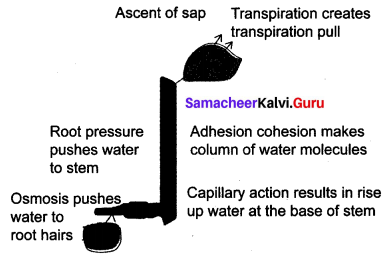
Question 4.
What would happen to the leaves of a plant that transpires more water than its absorption in the roots?
Answer:
If the rate of transpiration exceeds the rate of absorption, the stomata get closed the cells lose their turgidity and the plant wilts.
Question 5.
Describe the structure and working of the human heart.
Answer:
The human heart is four-chambered. The two upper thin-walled chambers, Auricle or Atria and the lower thick-walled chambers ventricles. The chambers are separated by a septum. The two auricles are separated by an interatrial septum and the two ventricles are separated by the interventricular septum.
The right atrium receives deoxygenated blood from different parts of the body through superior vena cava, inferior vena cava and coronary sinus. Pulmonary veins bring oxygenated blood from the lungs to the left atrium. Both the right and the left auricles pump blood into the right and left ventricles respectively.
From the right ventricle, the pulmonary arteries supply deoxygenated blood to the lungs. From the left ventricle, the Aorta carries the Oxygenated blood to the various organs of the body. The coronary arteries supply blood to the heart. This process is repeated again and again.
Question 6.
Why is the circulation in man referred to as double circulation?
Answer:
In human, blood passes twice through the heart to supply once to the body.
Double circulation involves: (i) Systemic circulation, (ii) Pulmonary circulation.
(i) Systemic circulation: In systemic circulation, from the left ventricle blood is pumped into the aorta and to various parts of the body.
(ii) Pulmonary circulation: In pulmonary circulation, from right ventricle deoxygenated blood is pumped into pulmonary artery which carries blood to the lungs for oxygenation.
Question 7.
What are heart sounds? How are they produced?
Answer:
The rhythmic closure and opening of the valves cause the sound of the heart. When the closure of the tricuspid and bicuspid valves after the beginning of ventricular systole, the sound ‘LUBB’ is produced. When the closure of the semilunar valve at the end of ventricular systole, the sound ‘DUPP’ is produced.
Question 8.
What is the importance of valves in the heart?
Answer:
The valves in heart are muscular flap that regulates the flow of blood in a single direction and prevents back flow of blood.
![]()
Question 9.
Who discovered the Rh factor? Why was it named so?
Answer:
The Rh factor was discovered by Landsteiner and Wiener in 1940 in Rhesus monkey. So it was named the Rh factor.
Question 10.
How are arteries and veins structurally different from one another?
Answer:
| Artery | Vein |
| 1. Distributing vessel | 1. Collecting vessel |
| 2. Pink in colour | 2. Red in colour |
| 3. Deep location | 3. Superficial in location |
| 4. Blood flow with high pressure | 4. Blood flow with low pressure |
| 5. Wall of an artery is strong, thick and elastic | 5. Wall of a vein is weak, thin and non-elastic |
| 6. All arteries carry oxygenated blood except pulmonary arteries | 6. All veins carry deoxygenated blood except pulmonary veins |
| 7. Internal valves are absent | 7. Internal valves are present |
Question 11.
Why is the Sinoatrial node called the pacemaker of heart?
Answer:
Although impulse is produced by the entire neuro muscular pathway, the frequency of impulse generation is maximum in case of Sino atrial node in comparison to other parts of pathway. Hence it guides the rhythm of heart beat and is called the pacemaker of the heart.
Question 12.
Differentiate between systemic circulation and pulmonary circulation.
Answer:
| Systemic Circulation | Pulmonary Circulation |
| 1. Circulation of oxygenated blood from the left ventricle of the heart to various organs of the body. | 1. Circulation starts in the right ventricle of the heart and reaches the lungs with deoxygenated blood. |
| 2. Return of deoxygenated blood to the right atrium. | 2. Pulmonary Artery collects the oxygenated blood from the lungs. |
| 3. Aorta carries oxygenated blood to all the organs of the body. | 3. The Oxygenated blood is supplied to the left atrium of the heart by the Pulmonary. |
Question 13.
The complete events of the cardiac cycle last for 0.8 sec. What is the timing for each event?
Answer:
- Auricular systole – Contraction of auricles = 0.1 sec
- Ventricular systole – Contraction of ventricle = 0.3 sec
- Ventricular diastole – Relaxation of ventricle = 0.4 sec
VII. Give reasons for the following Statements.
Question 1.
Minerals cannot be passively absorbed by the roots.
Answer:
The minerals cannot be passively absorbed by the roots because
- The minerals are present in the soil as charged particles (ion) and cannot move across the cell membrane.
- The concentration of minerals in the soil is lower than the concentration of minerals in the root.
Question 2.
Guard cells are responsible for opening and closing of Stomata.
Answer:
Opening and closing of stomata takes place due to changes in turgor of guard cell. The turgor changes in the guard cells are due to entry and exit of water into and out of the guard cells. During the day, water from the subsidiary cells enter the guard cells making it fully turgid causing the stomata to open. During night time, water from guard cells enters the subsidiary cells makes the guard cells flaccid causing the stomata closes.
Question 3.
The movement of substances in the phloem can be in any direction.
Answer:
The movement of substance in the Phloem can be in any direction because, the food to reach the plant parts like stem, leaves, flower, bud, seeds etc, the movement can be upwards or downwards, that is bidirectional.
![]()
Question 4.
Minerals in the plants are not lost when the leaf falls.
Answer:
Minerals are remobilised from older drying leaves to younger leaves. Elements like phosphorous, sulphur, nitrogen, potassium are easily mobilised, while elements like calcium are not remobilised. This can be seen in decidous leaves.
Question 5.
The walls of the right ventricle are thicker than the right auricles.
Answer:
The walls of the right ventricle are thicker than the right auricle because, the right ventricle has to pump out the blood with force to the Pulmonary trunk, which bifurcates to form the right and left Pulmonary Arteries.
Question 6.
Mature RBC in mammals do not have cell organelles.
Answer:
The RBCs are devoid of nucleus, mitochondria ribosome and endoplasmic reticulum. The absence of these organelles accommodates more haemoglobin thereby maximising the oxygen carrying capacity of the cell. Biconcave shape increase the surface area for oxygen binding, loss of mitochondria allow the RBC to transport all the oxygen to tissues and loss of endoplasmic reticulum allows more flexibility for RBC to move through the narrow capillaries.
VIII. Long Answer Questions.
Question 1.
How do plants absorb water? Explain.
Answer:
There are millions of root hairs on the tip of the root, which absorb water and minerals by diffusion. Diffusion takes place across cell membranes. Root hairs are a thin-walled, slender, extension of Epidermal cell, that increases the surface area of absorption. Active transport utilises energy to pump molecules against a concentration gradient. Active transport is carried out by membrane – bound proteins. These proteins use energy to carry substances across the cell membrane.
The cell wall of root hair is permeable and allows the water and minerals to enter. The cell membrane is semi – permeable. So it allows movement of water molecules from the region of higher concentration to the region of lower concentration. Once the water enters the root hairs, the concentration of water molecules in the root hair cells become more than that of Cortex. So the water from the root hair moves to the cortical cells by osmosis and then reaches the xylem.
Due to transpiration, the water is lost from the leaves and pressure is created at the top to pull more water from the xylem to the mesophyll cells, by the process of Transpiration pull. This extends up to the roots causing the roots to absorb more water from the soil to ensure the continuous flow of water from the roots to the leaves.
Question 2.
What is transpiration? Give the importance of transpiration.
Answer:
The loss of water from the aerial parts of plant in the form of vapours is called transpiration.
Importance of transpiration:
- Creates transpirational pull for transport of water.
- Supplies water for photosynthesis.
- Transports minerals from soil to all parts of the plant.
- Cools the surface of the leaves by evaporation.
- Keeps the cells turgid; hence, maintains their shape.
Question 3.
Why are leucocytes classified as granulocytes and agranulocytes? Name each cell and mention its functions.
Answer:
White blood corpuscles are colourless. They are nucleated cells. They are found in the bone marrow, spleen, thymus and lymph nodes. They are grouped into two categories:
1. Granulocytes: They contain granules in their cytoplasm. Their nucleus is irregular or lobed. The granulocytes are of three types:
- Neutrophils: They are large in size and have a 2 – 7 lobed nucleus. Their numbers are increased during infection and inflammation.
- Eosinophils: It has a bilobed nucleus. Their numbers increases during conditions of allergy and parasitic infections. It brings about the detoxification of toxins.
- Basophils: Basophils have a lobed nucleus. They release chemicals during the process of inflammation.
2. Agranulocytes: Granules are not found in the cytoplasm of these cells. Thy is of two types:
- Lymphocytes: Lymphocytes produce antibodies during bacterial and viral infections.
- Monocytes: They are the largest of the leucocytes and are amoeboid in shape. They are phagocytic and can engulf bacteria.
Question 4.
Differentiate between systole and diastole. Explain the conduction of heart beat.
Answer:
systole:
The contraction of heart is called systole.
diastole:
The relaxation of heart is called diastole.
Conduction of heart beat : The heart in human is myogenic. The cardiac cells with fastest rhythm are called the pacemaker cells. These cells are located in the right sino-atrial node. The impulse from the sino-atrial node. spreads as a wave of contraction over the right and left atrial wall pushing the blood through the atrio ventricular valves into the ventricle. Two special cardiac muscles fibres originate from the auriculo ventricular node and are called the bundle of his which runs down into the interventricular septum and the fibres spread into the ventricles. These fibres are called the Purkinje.
![]()
Question 5.
Enumerate the functions of blood.
Answer:
Functions of blood:
- Transport of respiratory gases (Oxygen and CO2).
- Transport of digested food materials to different body cells.
- Transport of hormones.
- Transport of nitrogenous excretory products like ammonia, urea and uric acid.
- It is involved in the protection of the body and defence against diseases.
- It acts as a buffer and also helps in the regulation of pH and body temperature.
- It maintains proper water balance in the body.
IX. Assertion and Reasoning Questions.
Direction: In each of the following questions a statement of assertion (A) is given and a corresponding statement of Reason (R) is given just below it. Mark the correct statement as:
(a) If both A and R are true and R is the correct explanation of A.
(b) If both A and R are true but R is not the correct explanation of A.
(c) A is true but R is false.
(d) Both A and R are false.
Question 1.
Assertion: RBC plays an important role in the transport of respiratory gases.
Reason: RBC does not have cell organelles and nucleus.
Answer:
(a) If both A and R are true and R is the correct explanation of A.
Question 2.
Assertion: Persons with AB blood group are called universal recipients because they can receive blood from all groups.
Reason: Antibodies are absent in persons with AB blood group.
Answer:
(a) If both A and R are true and R is the correct explanation of A.
X. Higher Order Thinking Skills (HOTS) Questions
Question 1.
When any dry plant material is kept in water, they swell up. Name and define the phenomenon involved in this change.
Answer:
The swelling up is due to Imbibition. Imbibition is a type of diffusion in which a solid absorbs water and gets swelled up. If Imbibition were not there, seedlings would not have been able to emerge out of the soil.
Question 2.
Why are the wails of the left ventricle thicker than the other chambers of the heart?
Answer:
The left ventricles have thick walls because the ventricle have to pump out blood with force away from the heart.
Question 3.
Doctors use a stethoscope to hear the sound of the heart. Why?
Answer:
The heart sound is heard by placing the stethoscope on the chest. It is a useful diagnostic tool to identify and localize the health problems and diagnose disease.
Question 4.
How does the pulmonary artery and pulmonary vein differ in their function when compared to a normal artery and vein?
Answer:
- All arteries carry oxygenated blood except the pulmonary artery which carry deoxygenated blood to the lungs.
- All veins carry deoxygenated blood except the pulmonary vein which carry oxygenated blood from the lungs to the heart.
Question 5.
Transpiration is a necessary evil in plants. Explain.
Answer:
Transpiration is a necessary evil in plants because it is inevitable but potentially harmful. Loss of water from the plant results wilting and cause the death of a plant if a condition of drought is experienced.
But transpiration is a great significance for the plant.
- Water is conducted, in most tall plants due to transpiration pull.
- Minerals dissolved in water are distributed throughout the plant body by Transpiration Stream.
- Evaporation of water from the cells of leaves has a cooling effect on plants.
- The wet surface of leaf cells allows gaseous exchange.
Textbook Activities Solved
Activity 1.
Demonstration of Osmosis: A thistle funnel whose mouth is covered with a semipermeable membrane is filled with sucrose solution. It is kept inverted in a beaker containing water. The water will diffuse across the membrane due to osmosis and raise the level of the solution in the funnel.
Answer:
A thistle funnel, whose mouth is covered with parchment paper, which acts as a semi-permeable membrane, is filled with sucrose solution. The funnel is kept inverted in a beaker, containing water. The water from the beaker enters or diffuse across the membrane from the region of water higher concentration to the water lower concentration (Sucrose Solution) through Semi – Permeable membrane, by osmosis. This causes the rise of the level of a solution in the funnel.
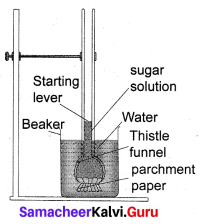
Activity 2.
Demonstration of Root Pressure: Choose a small soft – stemmed plant. Cut the stem horizontally near the base with a blade in the morning. You will see drops of solution oozing out of the cut stem due to root pressure.
Answer:
We will see drops of solution Oozing out of the cell stem. The Root Pressure, which pushes ^the solution up from the base.
Activity 3.
Determining Heart Rate?
Answer:
Materials:
- Stopwatch or Stop clock.
Procedure:
- Have your partner to find the pulse in your wrist and count your heartbeats for 15 seconds while you are seated. Calculate your resting heart rate in beats per minute.
- Have your partner to count your heart beats for 15 seconds after you jog or run for 5 minutes. Calculate your heart rate in beats per minute.
Analyse:
(i) What causes your pulse?
(ii) What causes the change in your heartbeat rate in each situation? You can write the answer yourself.
Answer:
(i) Pulse, rhythmic dilation of an artery generated by the opening and closing of the aortic valve in the heart. A pulse can be felt by applying firm fingertip pressure to the skin at sites where the arteries travel near the skin’s surface; it is more evident when surrounding muscles are relaxed.
(ii) You can write the answer yourself.
Samacheer Kalvi 10th Science Transportation in Plants and Circulation in Animals Additional Questions Solved
I. Fill in the blanks.
Question 1.
______ is responsible for the movement of water up to the base of the stem.
Answer:
Root pressure.
Question 2.
The other name for Red blood corpuscles (RBC) is called ______.
Answer:
Erythrocytes.
Question 3.
The apices of the flaps of tricuspid valves are held in position by ______.
Answer:
Chordaetendinae.
Question 4.
The supply of blood to the heart muscles is called ______ circulation.
Answer:
Coronary.
Question 5.
Sinuses are the body cavities which are called ______.
Answer:
Haemocoel.
II. Write True or False for the following statements. Write the true statement for the false statement.
Question 1.
Root hairs are a thin-walled, slender extension of Parenchyma cells.
Answer:
False.
Correct Statement: Root hairs are a thin-walled, slender extension of epidermal cell.
Question 2.
The transpiration pull sucks the water column from the xylem tubes so that the water is able to rise up in the tallest plants. Answer:
True.
![]()
Question 3.
The force of attraction between the molecules of companion cells is called cohesion.
Answer:
False.
Correct Statement: The force of attraction between the molecules of water is called cohesion,
Question 4.
Blood platelets help in the clotting of blood, form clot at the site of injury and prevent blood loss.
Answer:
True.
III. Match the following.
Question 1.
| 1. Universal Recipient | (a) Left Atrio Ventricular Valve |
| 2. Blood | (b) Thin and non-elastic cells |
| 3. Thymocytes | (c) Blood group AB |
| 4. Universal Donor | (d) Thick and elastic cells |
| 5. Mitral | (e) Blood group ‘O’ |
| 6. Veins | (f) Blood platelets |
| 7. Arteries | (g) Connective tissue |
Answer:
- (c) Blood group AB
- (g) Connective tissue
- (f) Blood platelets
- (e) Blood group ‘O’
- (a) Left Atrio Ventricular Valve
- (b) Thin and non-elastic cells
- (d) Thick and elastic cells
IV. Answer the following in a word or a Sentence.
Question 1.
What is Root Pressure?
Answer:
As ion from the Soil is actively transported into the Vascular tissue of the root, water moves along and increases the pressure inside the Xylem. This pressure is called root pressure.
Question 2.
What is the role of valves in heart?
Answer:
The valves are muscular flap that regulates the flow of blood in a single direction and prevent back flow of blood.
Question 3.
What is capillary action?
Answer:
Water or any liquid rises in a capillary tube because of physical forces. This phenomenon is called capillary action.
Question 4.
What is normal heart beat in man? How does it occur?
Answer:
The normal heart beat in man is about 72 – 75 times per minute. Rhythmic contraction and expansion of heart causes heart beat.
Question 5.
What are capillaries?
Answer:
Capillaries are narrow tubes formed by branching of arterioles which then unite to form the venules and veins. Capillaries are formed of a single layer of endothelial cells.
Question 6.
What is a pulse?
Answer:
The expansion of the artery every time, the blood is forced into it is called pulse. Normal pulse rate ranges from 70 – 90 per minute.
![]()
Question 7.
What is Cardiac Cycle?
Answer:
The sequence of events occurring from the beginning to the completion of one heartbeat is called the Cardiac Cycle.
Question 8.
What is hypertension?
Answer:
The condition, where a prolonged or constant elevation of blood pressure exist is called hypertension (High blood pressure)
Question 9.
What is Apoplast pathway?
Answer:
The apoplastic movement of water occurs through the intercellular spaces and the walls of the cells with gradient energy.
Question 10.
Why are membrane – bound proteins called pumps?
Answer:
Active transport is carried out by membrane-bound proteins. These proteins use energy to carry substances across the cell membrane. So they are called pumps.
Question 11.
When does plasmolysis occur?
Answer:
Plasmolysis occur when water moves out of the cell and resulting in the shrinkage of cell membrane away from the cell wall.
Question 12.
What are Lymph nodes?
Answer:
Lymph nodes are small oval or fan-shaped structures, located along the length of lymphatic vessels.
V. Answer the following briefly.
Question 1.
Define the following.
- Diffusion
- Osmosis
- Plasmolysis
Answer:
- Diffusion: The movement of molecules in liquid and solids from a region of higher concentration to a region of lower concentration, without the utilization of energy is called Diffusion.
- Osmosis: Osmosis is the movement of solvent or water molecules, from the region of higher concentration to the region of lower concentration through a semi – permeable membrane.
- Plasmolysis: Plasmolysis is a process, which occurs, when water moves out of the cell and resulting in the shrinkage of the cell membrane, away from the cell wall.
Question 2.
Explain cardiac cycle.
Answer:
The sequence of events occurring from the beginning to the completion of one heart beat is called cardiac cycle. During cardiac cycle blood flows ’ through the chambers of the heart in a specific direction. Each cardiac cycle lasts about 0.8 second. The events during a single cardiac cycle involves
- Atrial systole: Contraction of auricles (0.1 sec)
- Ventricular systole: Contraction of ventricles (0.3 sec)
- Ventricular diastole: Relaxation of ventricles (0.4 sec)
![]()
Question 3.
Explain the two types of Circulatory System.
Answer:
The two types of Circulatory System in animals are
- Open type: The blood is pumped by the heart into blood vessels, that open into blood spaces called sinuses, which are the body cavities called haemocoel. Capillary System is absent. Eg. Arthropods, Molluscs, Ascidians.
- Clsed type: The blood flows in a complete circuit around the body, through specific blood vessels. The blood flows from arteries to veins, through small blood vessels called capillaries. Eg. Vertebrates.
Question 4.
What is Blood Pressure? How is blood pressure expressed?
Answer:
The force exerted during the flow of blood against the lateral walls of arteries is called Blood Pressure. Blood pressure is usually expressed in terms of systolic pressure and diastolic pressure.
- Systolic pressure: The pressure, during ventricular systole, the left ventricle contracts and forces the blood into the aorta is called systolic pressure.
- Diastolic pressure: The pressure, during diastole, the ventricle relaxes and the pressure falls to the lowest value, is called Diastolic pressure.
In a healthy adult, during the normal resting condition, the systolic and diastolic blood pressure is expressed as 120mm / 80mm Hg.
Question 5.
In a Tabular Column, mention the distribution of Antigen (RBC) and antibody (Plasma) in different blood groups.
Answer:
| Blood Group | Antigens on RBC | Antibodies in Plasma | Can donate to | Can receive from |
| A | Antigen A | anti – b | A and AB | A and O |
| B | Antigen B | anti – a | B and AB | B and O |
| AB | Antigen A and B | No Antibody | AB | A, B, AB and O (Universal Recipient) |
| O | No Antigen | Both anti a and b | A, B, AB and O (Universal Donor) | O |
Question 6.
Write a note on valves of human.
Answer:
Valves : The valves are the muscular flaps that regulate the flow of blood in a single direction and prevent back flow of blood. The heart contains three types of valves. Right atrioventricular valve : It is located between the right auricle and right ventricle.
It has three thin triangular leaf like flaps and therefore called tricuspid valve. The apices of the flaps are held in position by chordae tendinae arising from the muscular projection of the ventricle wall known as papillary muscles.
Left atrioventricular valve : It is located between the left auricle and left ventricle. It has two cusps and therefore called bicuspid or mitral valve.
Semilunar valves : The major arteries (pulmonary artery and aorta) which leave the heart have semilunar valves which prevent backward flow of blood into the ventricles. They are the pulmonary and aortic semilunar valves.
Question 7.
What is Sphygmo Manometer? Name the instruments used to measure Blood pressure.
Answer:
The sphygmomanometer is a clinical instrument used to measure blood pressure when a person is in a relaxed and resting condition. The pressure of the brachial artery is measured. It helps to estimate the state of blood circulation and the working of the heart. It helps to diagnose conditions such as increased or decreased blood pressure. Monometric and modem digital types are used to measure blood pressure.
Question 8.
What are the factors which affect transpiration?
Answer:
Transpiration is affected by several external and internal factors.
- External factors: Temperature, light, humidity, and wind speed.
- Internal factors: Number and distribution of Stomata, Percentage of open stomata, Water status of the plant and Canopy Structure.
VI. Draw a labelled diagram for the following.
Question 1.
(a) Root tip with root hairs.
(b) Guard cell in turgid and Flacid condition.
Answer:
(a)
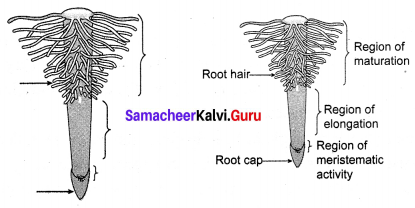
(b)
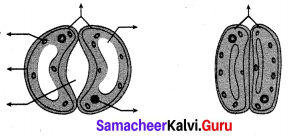
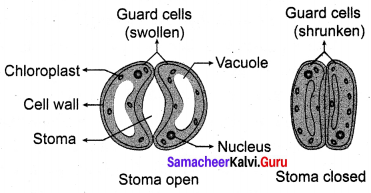
Question 2.
Draw a labelled diagram of the internal structure of Human Heart.
Answer:
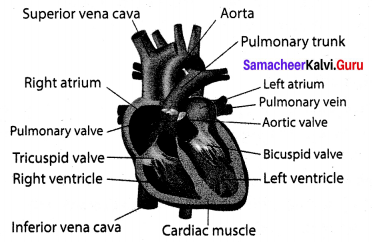
VII. Answer the following in detail.
Question 1.
Explain the types of Blood Circulation.
Answer:
The blood circulates in our body as oxygenated and deoxygenated blood. The types of circulation are:
- Systemic Circulation: Circulation of oxygenated blood from the left ventricle of the heart to various organs of the body and return of deoxygenated blood to the right atrium. Aorta carries oxygenated blood to all the organs of the body.
- Pulmonary Circulation: The path of pulmonary circulation starts in the right ventricle. Pulmonary artery arises from the right ventricle and reaches the lungs with deoxygenated blood. Pulmonary veins collect the oxygenated blood from the lungs and supplies it to the left atrium of the heart.
- Coronary circulation: The supply of blood to the heart muscles (cardiac muscles) is called coronary circulation. Cardiac muscles receive oxygenated blood from coronary arteries, that originate from the aortic arch. Deoxygenated blood from the cardiac muscles, drains into the right atrium by the coronary sinuses.
In human, the blood circulates twice, through the heart in one complete cycle, called double circulation. The oxygenated blood does not mix with the deoxygenated blood.
Question 2.
Explain the Lymphatic System with diagram and mention the function of Lymph.
Answer:
The lymphatic system consists of lymphatic capillaries, lymphatic vessels, lymph nodes and lymphatic ducts.
Lymph is a fluid, that flows through the lymphatic system. The lymphatic capillaries unite to form large lymphatic vessels. Lymph nodes are small, oval or pear-shaped structures located along the lymphatic vessels.
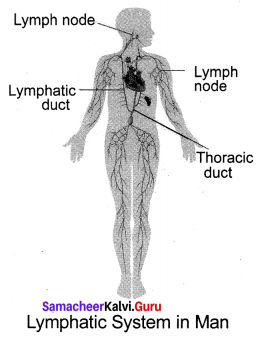
Lymph from the intercellular spaces drains into lymphatic capillaries. Lymph is a colourless fluid formed when Plasma, Proteins and blood cells escape into intercellular spaces in the tissues, through the pores present in the walls of the capillaries. It is similar to blood plasma, but is colourless and contains fewer proteins. The lymph contains a very small amount of nutrients, Oxygen, CO2, water and WBC.
Functions of Lymph:
- Supplies nutrients and oxygen to those parts where blood cannot reach.
- It drains away excess tissue fluid and metabolites and returns proteins to the blood from tissue spaces.
- The lymph also carries absorbed fats from small intestine to the blood. The lymphatic capillaries of internal villi (lacteals) absorb digested fats.
- Lymphocytes in the lymph defend the body from infections.
VIII. Higher Order Thinking Skills (HOTS) Questions
Question 1.
What do you know about the following?
- Anaemia
- Leucocytosis
- Leukopenia
- Thrombocytopenia
Answer:
- Anaemia → Decrease in the number of Erythrocytes.
- Leucocytosis → Increase in the number of Leukocytes.
- Leukopenia → Decrease in the number of Leukocytes.
- Thrombocytopenia → Decrease in the number of Thrombocytes.
Question 2.
The cardiac pacemaker in a patient fails to function normally. The doctor finds that an artificial pacemaker is to be grafted in him. It is likely that it will be drafted at the site of.
Answer:
Sino-atrial node, which acts as the pacemaker of the heart because it is capable of initiating impulse which can stimulate the heart muscles to contraction.
Question 3.
What do you know about the following important terms, which we come across every day?
- Heart attack
- Cardiac arrest
- Heart Failure.
Answer:
- Heart attack: The blood flow to the heart is blocked. A blockage of blood flow to the heart muscle. The heart muscle affected from lack of blood supply.
- Cardiac arrest: The heart stops beating and needs to be restarted. Cardiac arrest is an electrical problem, triggered by a disruption of the heart’s rhythm.
- Heart Failure: Heart Failure occurs, when the heart muscle fails to pump as much as blood as the body needs. It may come to a person suddenly.
Question 4.
Removal of ring wood of tissue outside the vascular cambium from the tree trunk kills it because:
Answer:
Food does not travel down and root becomes starved (Translocation of food).